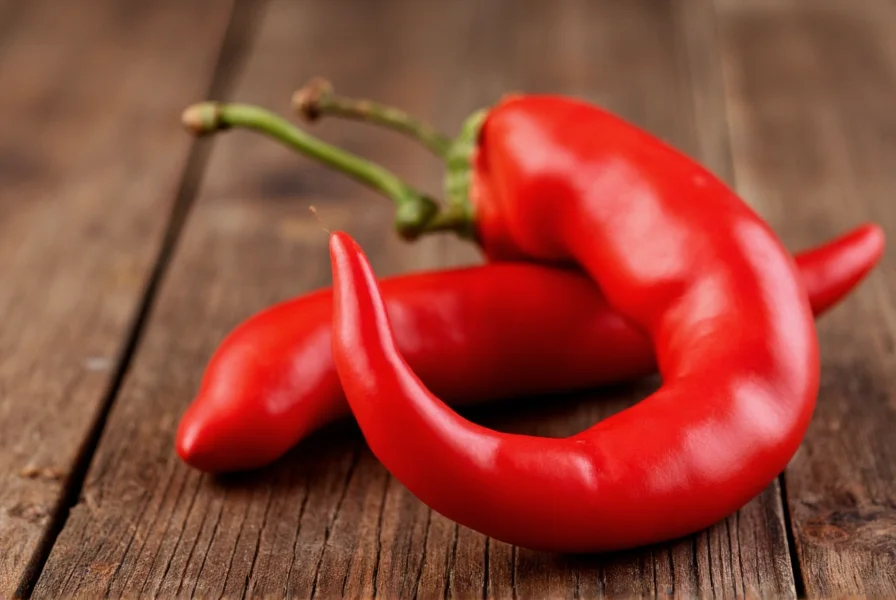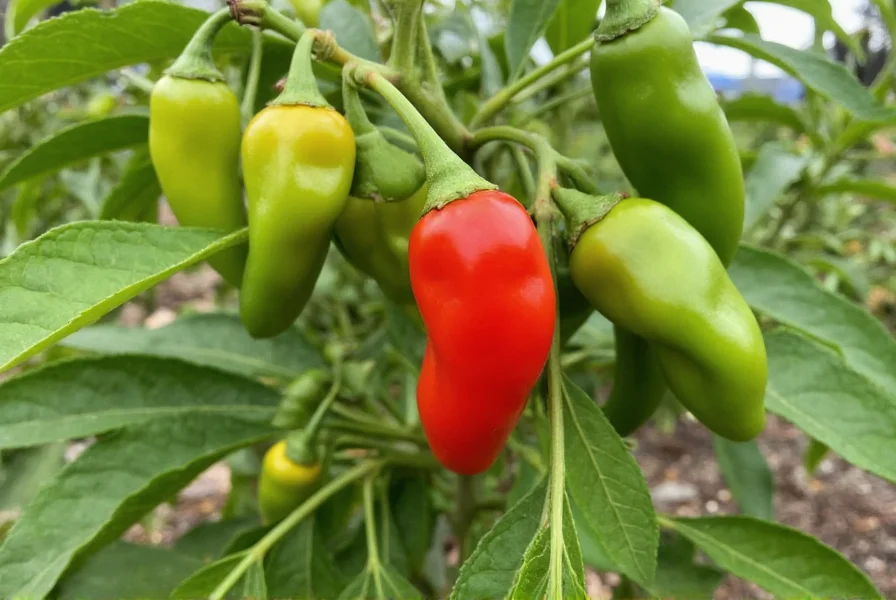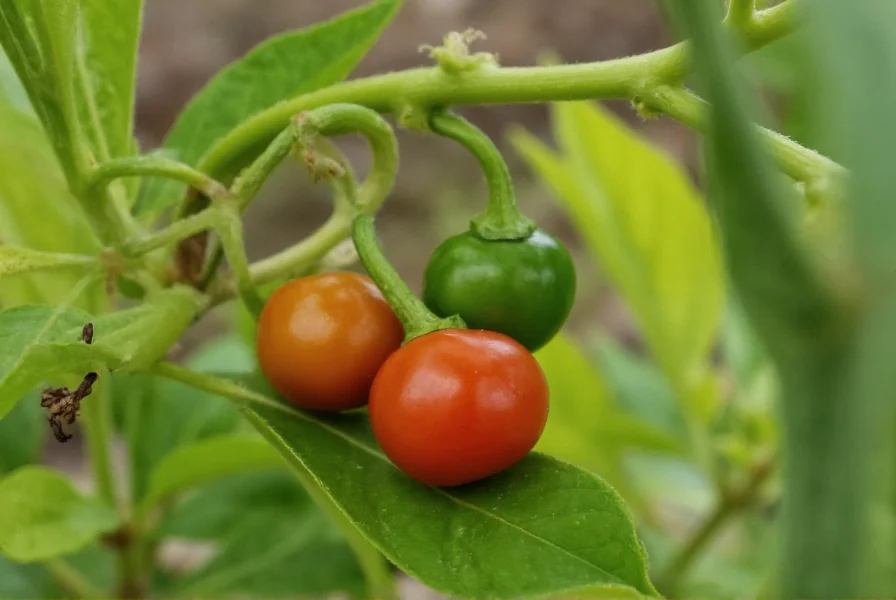Nardello peppers, scientifically classified as Capsicum annuum, represent one of the most versatile sweet pepper varieties in Italian culinary tradition. These elongated, tapered peppers typically measure 6-8 inches in length with a distinctive curved shape that sets them apart from standard bell peppers. When immature, they appear green, gradually transforming to a brilliant crimson red as they reach full maturity. Unlike many pepper varieties, Nardello peppers maintain exceptional thin walls that cook quickly and evenly, making them ideal for various cooking methods without becoming tough or rubbery.
Physical Characteristics and Identification
Identifying Nardello peppers is relatively straightforward due to their unique physical attributes. These peppers feature a distinctive curved or twisted shape, often described as "corkscrew-like," with a tapered point at one end. The skin remains exceptionally thin throughout ripening, contributing to their culinary versatility. When selecting Nardello peppers at farmers' markets or specialty grocers, look for firm specimens with smooth, unblemished skin and vibrant coloration. The transition from green to red occurs gradually, with many specimens showing beautiful gradient color patterns during ripening.
| Characteristic | Nardello Pepper | Compared to Bell Pepper |
|---|---|---|
| Shape | Curved, tapered, often twisted | Blocky, square-shaped |
| Wall Thickness | Very thin | Thick |
| Typical Length | 6-8 inches | 3-4 inches |
| Heat Level | 0-500 SHU (sweet) | 0 SHU (sweet) |
Flavor Profile and Heat Assessment
The flavor profile of Nardello peppers distinguishes them from other sweet pepper varieties. They offer a complex sweetness with subtle fruity notes and a hint of earthiness that intensifies when cooked. Unlike bell peppers which maintain consistent sweetness, Nardello peppers develop richer, almost caramel-like flavors when roasted or sautéed. Their heat level registers between 0-500 Scoville Heat Units (SHU), placing them firmly in the sweet pepper category with virtually no noticeable heat. This makes them accessible to those who typically avoid spicy foods while still providing the depth of flavor associated with certain chili varieties.
When evaluating Nardello peppers for culinary use, consider their ripeness stage. Green Nardello peppers offer a brighter, slightly grassier flavor profile, while fully ripened red specimens deliver deeper sweetness with more pronounced fruity notes. The thin walls ensure quick cooking without becoming waterlogged, a common issue with thicker-walled sweet peppers.

Culinary Applications and Recipe Integration
Nardello peppers excel in numerous cooking techniques that highlight their delicate flavor and texture. Their thin walls make them particularly well-suited for quick cooking methods that preserve their integrity without becoming mushy. Professional chefs and home cooks alike prize these peppers for Italian dishes where pepper flavor should complement rather than dominate.
For optimal results when roasting Nardello peppers, place whole peppers directly over gas flames or under a broiler, turning frequently until evenly blistered. After cooling in a covered bowl, the skin slips off easily, revealing the tender flesh beneath. This technique enhances their natural sweetness and creates complex flavor compounds through the Maillard reaction. Roasted Nardello peppers maintain their shape better than many other varieties, making them ideal for presentation-focused dishes.
When sautéing Nardello peppers, slice them into 1/4-inch strips and cook in olive oil over medium heat. Unlike thicker peppers that require extended cooking to become tender, Nardello peppers achieve perfect texture in just 5-7 minutes. Their quick cooking time makes them excellent for last-minute additions to pasta dishes, omelets, or grain bowls where fresh pepper flavor is desired without prolonged cooking.
One traditional Italian preparation involves stuffed Nardello peppers. Their elongated shape provides an ideal vessel for fillings of rice, breadcrumbs, herbs, and cheese. Unlike bell peppers which often require par-cooking before stuffing, Nardello peppers can be stuffed raw and cooked completely in one step due to their thin walls. This method preserves more of their fresh flavor while achieving perfect tenderness.
Growing Nardello Peppers in Home Gardens
Gardeners seeking to cultivate Nardello peppers should note their specific growing requirements. These plants typically reach 24-36 inches in height with a spreading growth habit that benefits from staking as fruit develops. Nardello peppers require 70-80 days from transplanting to reach full maturity, with the color transition from green to red occurring over approximately 10-14 days once ripening begins.
For optimal growth, plant Nardello pepper seedlings after all danger of frost has passed and soil temperatures consistently exceed 65°F (18°C). These plants thrive in full sun with well-draining soil amended with organic matter. Consistent moisture is crucial during flowering and fruit set, though established plants demonstrate moderate drought tolerance. Unlike many hot pepper varieties, Nardello peppers don't require excessive heat to produce well, making them suitable for cooler Mediterranean climates.
Harvesting Nardello peppers at different stages offers culinary versatility. For sweet, slightly grassy flavor, pick when mostly green. For maximum sweetness and vibrant color, wait until fully red. The plants typically produce abundant yields throughout the growing season when regularly harvested, with each plant yielding approximately 25-35 peppers under optimal conditions.

Availability and Sourcing Options
Finding authentic Nardello peppers requires knowing where to look, as they're less common than standard bell peppers. During peak season (late summer through early fall), specialty grocers and farmers' markets represent the most reliable sources for fresh Nardello peppers. Italian specialty markets often carry them, particularly in regions with significant Italian-American populations.
When fresh Nardello peppers aren't available, several alternatives exist. Some premium grocery chains stock them frozen, which preserves their cooking qualities remarkably well. Dried Nardello peppers appear occasionally in specialty food stores, though these are less common than fresh specimens. For gardeners, numerous seed companies offer Nardello pepper seeds, with heirloom varieties providing the most authentic flavor profile.
When selecting substitutes for Nardello peppers, consider Cubanelle peppers for similar mild heat and thin walls, though they lack the distinctive curved shape. Sweet banana peppers offer comparable heat levels but with different flavor characteristics. For recipes specifically requiring the visual appeal of Nardello peppers, standard red bell peppers can work in a pinch, though they'll require longer cooking times and lack the same flavor complexity.
Storage and Preservation Techniques
Proper storage extends the usability of Nardello peppers significantly. When refrigerated in a perforated plastic bag in the crisper drawer, fresh Nardello peppers maintain quality for 2-3 weeks. For longer preservation, roasting and freezing represents the most effective method. After roasting, peeling, and slicing, store portions in airtight containers with a small amount of olive oil to prevent freezer burn.
Another excellent preservation method involves oil-packing roasted Nardello peppers. After roasting and peeling, pack peppers into sterilized jars, cover completely with olive oil, and process in a hot water bath for 15 minutes. Properly sealed jars maintain quality for up to one year when stored in a cool, dark place. This method preserves both flavor and texture remarkably well, making preserved Nardello peppers nearly indistinguishable from fresh in cooked applications.
Comparative Analysis with Similar Pepper Varieties
Understanding how Nardello peppers compare to similar varieties helps in selecting the right pepper for specific culinary applications. While all fall within the sweet pepper category, subtle differences significantly impact cooking results.
| Pepper Variety | Heat Level (SHU) | Wall Thickness | Flavor Profile | Best Cooking Method |
|---|---|---|---|---|
| Nardello | 0-500 | Very thin | Sweet, fruity, slightly earthy | Roasting, frying, stuffing |
| Cubanelle | 0-1,000 | Thin | Mildly sweet, slightly tangy | Stir-frying, sandwiches |
| Friar | 0-500 | Moderate | Balanced sweet, mild bitterness | Grilling, roasting |
| Bell | 0 | Thick | Crisp sweetness | Raw applications, stuffing |
The distinctive advantage of Nardello peppers lies in their combination of thin walls and complex flavor development when cooked. While Cubanelle peppers share similar heat levels, their thicker walls require longer cooking times and don't develop the same caramelized sweetness. Friar peppers offer comparable heat but with different flavor characteristics that work better in certain applications. Bell peppers, while widely available, lack the nuanced flavor profile that makes Nardello peppers special in traditional Italian preparations.
Traditional Italian Dishes Featuring Nardello Peppers
Nardello peppers feature prominently in several regional Italian dishes where their specific characteristics enhance the final product. In Liguria, they appear in peperoni ripieni (stuffed peppers) with a filling of breadcrumbs, pine nuts, and fresh herbs. The thin walls allow the peppers to cook completely while maintaining their shape, unlike thicker varieties that might remain undercooked in the center.
Another classic preparation comes from Tuscany: peperoni alla palermitana, where sliced Nardello peppers cook slowly with tomatoes, capers, and olives. The peppers' ability to absorb surrounding flavors while maintaining their integrity makes them perfect for this slow-cooked preparation. In southern Italy, roasted Nardello peppers often accompany melanzane alla parmigiana (eggplant parmesan), adding sweetness that balances the dish's richness.
For home cooks exploring authentic Italian cuisine, incorporating Nardello peppers into peperonata (a traditional sweet and sour pepper stew) yields exceptional results. The peppers' thin walls allow them to cook down quickly while maintaining distinct pieces, creating the perfect texture contrast between tender peppers and slightly crisp edges.
Conclusion
Nardello peppers represent a culinary treasure that bridges the gap between standard sweet peppers and more specialized varieties. Their unique combination of thin walls, distinctive curved shape, and complex flavor profile makes them invaluable for specific cooking applications, particularly in Italian cuisine. Whether sourcing them from specialty markets or growing them in home gardens, understanding their characteristics ensures optimal use in various culinary preparations. From roasting to stuffing, these versatile peppers elevate dishes with their subtle sweetness and ability to absorb complementary flavors while maintaining their integrity during cooking. For those exploring beyond standard bell peppers, Nardello peppers offer a rewarding addition to the culinary repertoire that enhances both traditional and contemporary dishes.











 浙公网安备
33010002000092号
浙公网安备
33010002000092号 浙B2-20120091-4
浙B2-20120091-4